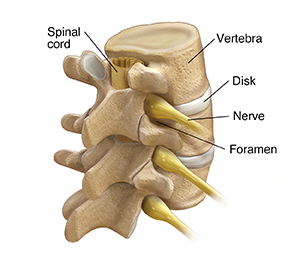Foraminotomy is a surgical procedure that enlarges the area around one of the bones in your spinal column. The surgery relieves pressure on compressed nerves.
Your spinal column is made up of a chain of bones called vertebrae. The intervertebral discs sit above and below the flat portion of each vertebra to provide support.
The spinal column houses your spinal cord and helps protect it from injury. The spinal cord sends sensory information from the body to the brain. The spinal cord also sends commands from the brain to the body. Nerves spread out from the spinal cord, sending and receiving this information. They exit the spinal column through a small hole (intervertebral foramen) that lies between the vertebrae.

Sometimes these openings can become too small. When that happens, the compressed nerve can cause symptoms such as pain, tingling in the arms and legs, and weakness. The exact symptoms depends on the location of the compressed nerve along the spinal column. (For example, a compressed nerve in the neck may lead to neck pain and tingling and weakness in the hand and arm.)
During your foraminotomy, Orthopaedic Surgeon will make a cut (incision) on your back or neck and expose the affected vertebra. Then he or she can surgically widen your intervertebral foramen, removing whatever blockages are present.
Causes of Foraminotomy
Blockages that narrow the spinal column or block an intervertebral foramen are called spinal stenosis. Various processes can block the intervertebral foramen and compress the nerve leaving the spinal cord. Conditions that can cause spinal stenosis include:
- Degenerative arthritis of the spine (spondylosis), which can cause bony spurs
- Degeneration of the intervertebral discs, which can cause them to bulge into the foramen
- Enlargement of the nearby ligament
- Spondylolisthesis
- Cysts or tumors
- Skeletal disease (like Paget disease)
- Congenital problems (like dwarfism)
Degenerative arthritis of the spine (from old age) is one of the most common causes.
This nerve compression can happen along any part of your spinal column. Your compressed nerve may start to cause symptoms, like pain in the affected region and tingling and weakness in the affected limb. You might need a foraminotomy if you’ve already tried other treatments and had no success. This includes physical therapy, pain medicines, and epidural injections.
Usually, your surgeon can do the surgery an elective procedure to help relieve these symptoms. You might need to have an emergency foraminotomy if your symptoms are quickly getting worse, or if you have problems with your bladder due to your nerve.
Procedure
Orthopaedic Surgeon, Dr. Dev Mishra at Shreya Hospital in Ghaziabad can help explain the details of your particular surgery. (The following outlines a minimally invasive type of foraminotomy. Incisions are wider in a traditional foraminotomy.) A neurosurgeon and a team of specialized nurses and healthcare professionals will perform the surgery. The whole surgery will take a couple of hours. In general, you can expect the following:
- During the procedure, you’ll lie on your stomach.
- You will be given medicine (anesthesia) to put you to sleep through the surgery. You won’t feel any pain or discomfort during the procedure.
- Someone will carefully monitor your vital signs, like your heart rate and blood pressure, during the surgery.
- Your surgeon will make a small incision just beside your spine on the side you have your symptoms. He or she will make the incision at the level of your affected vertebra.
- Your surgeon will use X-rays and a special microscope to guide the surgery.
- Using special tools, your surgeon will push away the back muscles around the spine to expose the blocked intervertebral foramen.
- Your surgeon will use small tools to remove the blockage inside the intervertebral foramen. The blockage may be a bone spur or a bulging disc. This will relieve pressure on the nerves.
- In some cases, your surgeon might do another procedure at this time, like a laminectomy. This removes part of the vertebra.
- The team will remove the tools and put your back muscles back in place. Someone will then close the small incision in your skin.
 Dr Dev Mishra Best Orthopaedic Doctor in Delhi NCR Ghaziabad
Dr Dev Mishra Best Orthopaedic Doctor in Delhi NCR Ghaziabad
